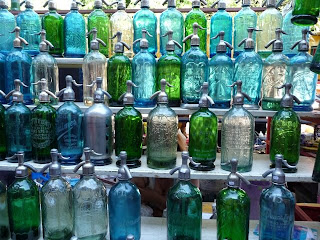
Christian holding a tortuga only a few hours old
At sunset on Ventanillo Beach this evening, we helped "liberate" 119 freshly hatched baby turtles, which had been incubating for 45 days and hatched earlier today. The endangered golfino turtles are helped along with their first big day by a cooperative of volunteers. When the mother turtle comes ashore to deposit her eggs, the volunteers dig up the newly laid eggs, transport them to a corral safe from predators, and once hatched, send them on their way down the beach under careful watch. Along with about ten other visitors, we assisted with the turtles' first sea voyage. The event was intense, jubilant and emotional - I choked up when a few stragglers seemed too tired to make it to the water. One little guy couldn't summon any more strength and died on the sand. We gently picked up the slow kids and placed them in the receding surf. Even so, the tide often sent them tumbling back up the beach - surely an unleasant experience. But again and again, they flipped over and headed with determination towards their aquatic destiny.

"My man doesn't need turtle eggs"
A poster to help educate against eating endangered turtles, a traditional food in Mexico believed to make men "strong."
Heading towards the sea
118 tortugas en route to the waves
D.H. Lawrence, who spent quite a bit of time in Oaxaca (of which he wrote about in The Plumed Serpent and Mornings in Mexico) penned the following poem in 1921. It is very possible he was describing the ancestors of the turtles we met today.
Baby Tortoise
You know what it is to be born alone,
Baby tortoise!
The first day to heave your feet little by little from the shell,
Not yet awake,
And remain lapsed on earth,
Not quite alive.
A tiny, fragile, half-animate bean.
To open your tiny beak-mouth, that looks as if it would never open,
Like some iron door;
To lift the upper hawk-beak from the lower base
And reach your skinny little neck
And take your first bite at some dim bit of herbage,
Alone, small insect,
Tiny bright-eye,
Slow one.
To take your first solitary bite
And move on your slow, solitary hunt.
Your bright, dark little eye,
Your eye of a dark disturbed night,
Under its slow lid, tiny baby tortoise,
So indomitable.
No one ever heard you complain.
You draw your head forward, slowly, from your little wimple
And set forward, slow-dragging, on your four-pinned toes, Rowing slowly forward.
Whither away, small bird?
Rather like a baby working its limbs,
Except that you make slow, ageless progress
And a baby makes none.
The touch of sun excites you,
And the long ages, and the lingering chill
Make you pause to yawn,
Opening your impervious mouth,
Suddenly beak-shaped, and very wide, like some suddenly gaping pincers;
Soft red tongue, and hard thin gums,
Then close the wedge of your little mountain front,
Your face, baby tortoise.
Do you wonder at the world, as slowly you turn your head in its wimple
And look with laconic, black eyes?
Or is sleep coming over you again,
The non-life?
You are so hard to wake.
Are you able to wonder?
Or is it just your indomitable will and pride of the first life
Looking round
And slowly pitching itself against the inertia
Which had seemed invincible?
The vast inanimate,
And the fine brilliance of your so tiny eye,
Challenger.
Nay, tiny shell-bird,
What a huge vast inanimate it is, that you must row against,
What an incalculable inertia.
Challenger,
Little Ulysses, fore-runner,
No bigger than my thumb-nail,
Buon viaggio.
All animate creation on your shoulder,
Set forth, little Titan, under your battle-shield.
The ponderous, preponderate,
Inanimate universe;
And you are slowly moving, pioneer, you alone.
How vivid your travelling seems now, in the troubled sunshine,
Stoic, Ulyssean atom;
Suddenly hasty, reckless, on high toes.
Voiceless little bird,
Resting your head half out of your wimple
In the slow dignity of your eternal pause.
Alone, with no sense of being alone,
And hence six times more solitary;
Fulfilled of the slow passion of pitching through immemorial ages
Your little round house in the midst of chaos.
Over the garden earth,
Small bird,
Over the edge of all things.
Traveller,
With your tail tucked a little on one side
Like a gentleman in a long-skirted coat.
All life carried on your shoulder,
Invincible fore-runner.


















































